Evolving Planet at the Field Museum (Part II)
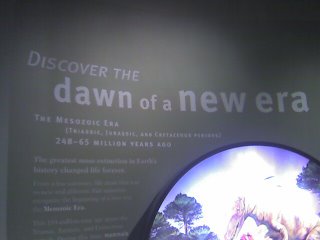 Welcome to part two of my three part series on the "Evolving Planet" exhibit at the Field Museum. It is part of a series that includes my thoughts on some of the general exhibits, the Underground Adventure, the King Tut exhibit, and part one of the Evolving Planet. The final entry on the Evolving Planet will come tomorrow.
Welcome to part two of my three part series on the "Evolving Planet" exhibit at the Field Museum. It is part of a series that includes my thoughts on some of the general exhibits, the Underground Adventure, the King Tut exhibit, and part one of the Evolving Planet. The final entry on the Evolving Planet will come tomorrow.This entry is about the truly impressive and fun part of the exhibit: the Mesozoic Era (248 to 65 Million Years Ago). This time period is also known as the "Age of the Dinosaurs". There was a new kind of species in town. It was the dawn of a true new era.
Before you go on, please note that these photos -- taken with a Treo 650 -- do not do the exhibit justice. My digital camera had run out of memory space, so I relied on my phone. The only way you can truly experience the power of this exhibit is to see it for yourself.
Be warned...
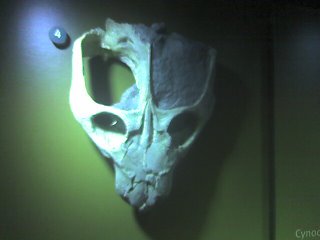 Cynodont fossils from this time period (248 to 206 million years ago in the Triassic Period) have been found. They had a new kind of teeth: canines and incisors, for biting and tearing. They also had back teeth for grinding or slicing. It was kind of free thinking that allow me to eat steaks millions of years later. It was an important part of animal and mammal development. Teeth remains are a big part of this section of the exhibit, as subtle differences are detected among different fossils.
Cynodont fossils from this time period (248 to 206 million years ago in the Triassic Period) have been found. They had a new kind of teeth: canines and incisors, for biting and tearing. They also had back teeth for grinding or slicing. It was kind of free thinking that allow me to eat steaks millions of years later. It was an important part of animal and mammal development. Teeth remains are a big part of this section of the exhibit, as subtle differences are detected among different fossils. This appears to be the remains of a Triassic Period reptile.
This appears to be the remains of a Triassic Period reptile.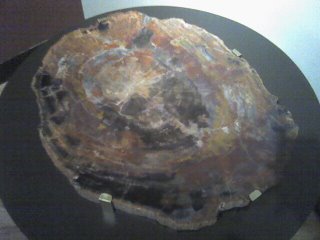 This is a cross-section of a conifer trunk. Scientists can surmise much about the past from the details left in trees, including things like its age and weather climate. The NASA Website has an explanation for this: in "a tree the cambium, the cells that will become wood or bark, grows in a light layer during late spring/early summer changing to a dark layer in later summer/early fall." Each ring, therefore, represents one year. It continues:
This is a cross-section of a conifer trunk. Scientists can surmise much about the past from the details left in trees, including things like its age and weather climate. The NASA Website has an explanation for this: in "a tree the cambium, the cells that will become wood or bark, grows in a light layer during late spring/early summer changing to a dark layer in later summer/early fall." Each ring, therefore, represents one year. It continues:These annual rings can be counted to tell the age of the tree, and because there is more growth under good conditions, the growth patterns can be studied to determine the conditions a tree lived through such as forest fires, drought, insect attack, floods, or slopes. The study of tree rings and climate is called dendroclimatology.This one (the photo above) is dated at 248-206 million years ago, or the Triassic Period.
A sign says "please touch." Here, you can get in close contact with our past. It's part of the reason why this room of the museum is a lot of fun to be in.
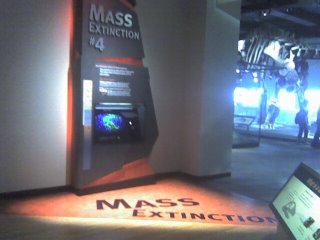 Teeth are exciting, but before things could really get going for dinosaurs a lot of other things had to die first.This leads us to Mass Extinction #4.
Teeth are exciting, but before things could really get going for dinosaurs a lot of other things had to die first.This leads us to Mass Extinction #4.It is believed that shifting continents (yes, they move, remember?) and volcanic activity (leading to global warming that Al Gore would be screaming about) killed off a lot of plant life that could not deal with warmer weather. At the same time, lower sea levels killed off a lot of marine life.
 The time was ripe for the real Jurassic Park to take place.
The time was ripe for the real Jurassic Park to take place. 70 million years ago is the likely home time for Sue, the dinosaur located in the main entrance of the Field Museum. This is the time period that many people think about when they speak about historical geology.
70 million years ago is the likely home time for Sue, the dinosaur located in the main entrance of the Field Museum. This is the time period that many people think about when they speak about historical geology. This is an example of a Ceratopsian, or "horn faced" animal. It is one of many dinosaur bones that fill a large room in the museum. It is a breathtaking display and the people of Chicago are lucky to have it.
This is an example of a Ceratopsian, or "horn faced" animal. It is one of many dinosaur bones that fill a large room in the museum. It is a breathtaking display and the people of Chicago are lucky to have it. This Daspletosaurus may have been an ancestor to Tyrannosaurus, one of the more famous dinosaurs. It is a theropod, or "beast-footed" dinosaur. These bones are organized in a logical way and information about them is provided with each fossil. It was amazing work done by the Field Museum staff.
This Daspletosaurus may have been an ancestor to Tyrannosaurus, one of the more famous dinosaurs. It is a theropod, or "beast-footed" dinosaur. These bones are organized in a logical way and information about them is provided with each fossil. It was amazing work done by the Field Museum staff. The Apatosaurus is a sauropod ("lizard hipped") dinosaur and may have weighed 33 tons. In the lower right section of the photo, in-between the dinosaur's back legs, you can see a person looking at the fossil. From there you get a sense of how big these bones are. It's a very impressive sight.
The Apatosaurus is a sauropod ("lizard hipped") dinosaur and may have weighed 33 tons. In the lower right section of the photo, in-between the dinosaur's back legs, you can see a person looking at the fossil. From there you get a sense of how big these bones are. It's a very impressive sight. Outside of the Carnegie Museum in Pittsburgh sits a statue of one of them. As you may recall I visited there last October and they had an impressive collection of dinosaur fossils as well. While that museum did a great job showing the bones, the Field Museum uses them to tell a larger story about the theory of evolution.
Outside of the Carnegie Museum in Pittsburgh sits a statue of one of them. As you may recall I visited there last October and they had an impressive collection of dinosaur fossils as well. While that museum did a great job showing the bones, the Field Museum uses them to tell a larger story about the theory of evolution.The UC Berkeley Website that I've relied on quite a bit for these posts brings up an interesting point about Jurassic Park the movie versus the time period:
Today, the name "Jurassic" conjures up images of the phenomenally successful book and movie, "Jurassic Park". It is quite true that the dinosaurs dominated the land fauna -- although many of the dinosaurs featured in "Jurassic Park", such as Triceratops and Tyrannosaurus rex, did not evolve until after the Jurassic was over. The largest dinosaurs of the time -- in fact, the largest land animals of all time -- were the gigantic sauropods, such as the famous Diplodocus (pictured at lower left), Brachiosaurus and Apatosaurus. Other herbivorous dinosaurs of the Jurassic included the plated stegosaurs. Predatory dinosaurs of the Jurassic included fearsome carnosaurs such as Allosaurus, small, fast coelurosaurs, and ceratosaurs such as Dilophosaurus. The Jurassic also saw the origination of the first birds, including the well-known Archaeopteryx, probably from coelurosaurian ancestors.
 The Mesozoic Period (251-65 million years ago) brings evidence of impressive varieties of sea life.
The Mesozoic Period (251-65 million years ago) brings evidence of impressive varieties of sea life. While dinosaurs are more popular, the museum shows their impressive collection of this time period's fossils. At this point, I was overwhelmed by what I was seeing.
While dinosaurs are more popular, the museum shows their impressive collection of this time period's fossils. At this point, I was overwhelmed by what I was seeing. This Ammonoid Mollusk is an example of the beautiful creatures that lived on Earth millions of years ago. They are also considered to be very good time index fossils. It is believed that the first Greek discus, perhaps used in the Olympics, was an ammonite fossil.
This Ammonoid Mollusk is an example of the beautiful creatures that lived on Earth millions of years ago. They are also considered to be very good time index fossils. It is believed that the first Greek discus, perhaps used in the Olympics, was an ammonite fossil.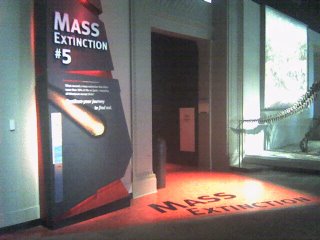 All good things must come to an end. All dinosaurs that were not birds would die in a fairly short period of time (geologically). Called the Cretaceous-Tertiary extinction, it is a source of some controversy as to why Mass Extinction #5 happened. It could have been an asteroid or comet. It could have been a supernova. Perhaps volcanic activity?
All good things must come to an end. All dinosaurs that were not birds would die in a fairly short period of time (geologically). Called the Cretaceous-Tertiary extinction, it is a source of some controversy as to why Mass Extinction #5 happened. It could have been an asteroid or comet. It could have been a supernova. Perhaps volcanic activity?As for me, the answer is clear. Jell-O killed the dinosaurs.
We do know this (well, about as well as any scientist today can know): 50% of all life on Earth was wiped away, paving the way for beings like us to take over the Earth.
That's good for us too. I don't think we would have been able to handle the dinosaurs.
In part three of three, my next post on the Evolving Planet, I'll talk about us.
RELATED LINKS:
Henri D. Grissino-Mayer's Dendrochronology (Tree Ring) Website
PBS: What Killed the Dinosaurs?
What Killed the Dinosaurs? A paper on the subject.

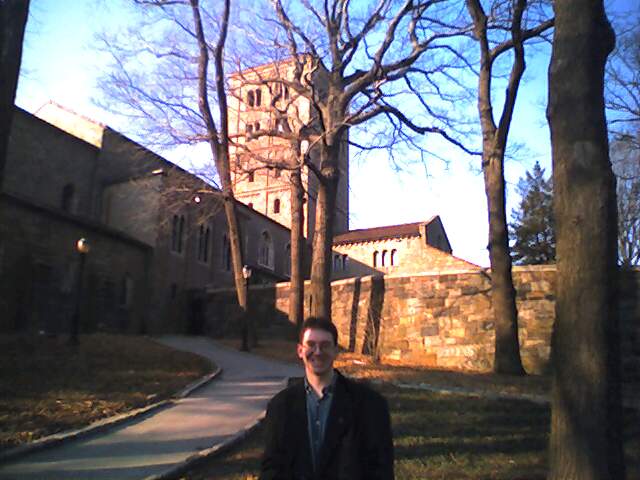

0 Comments:
Post a Comment
|<< Home